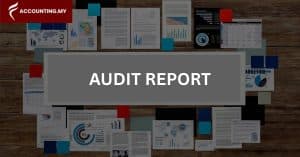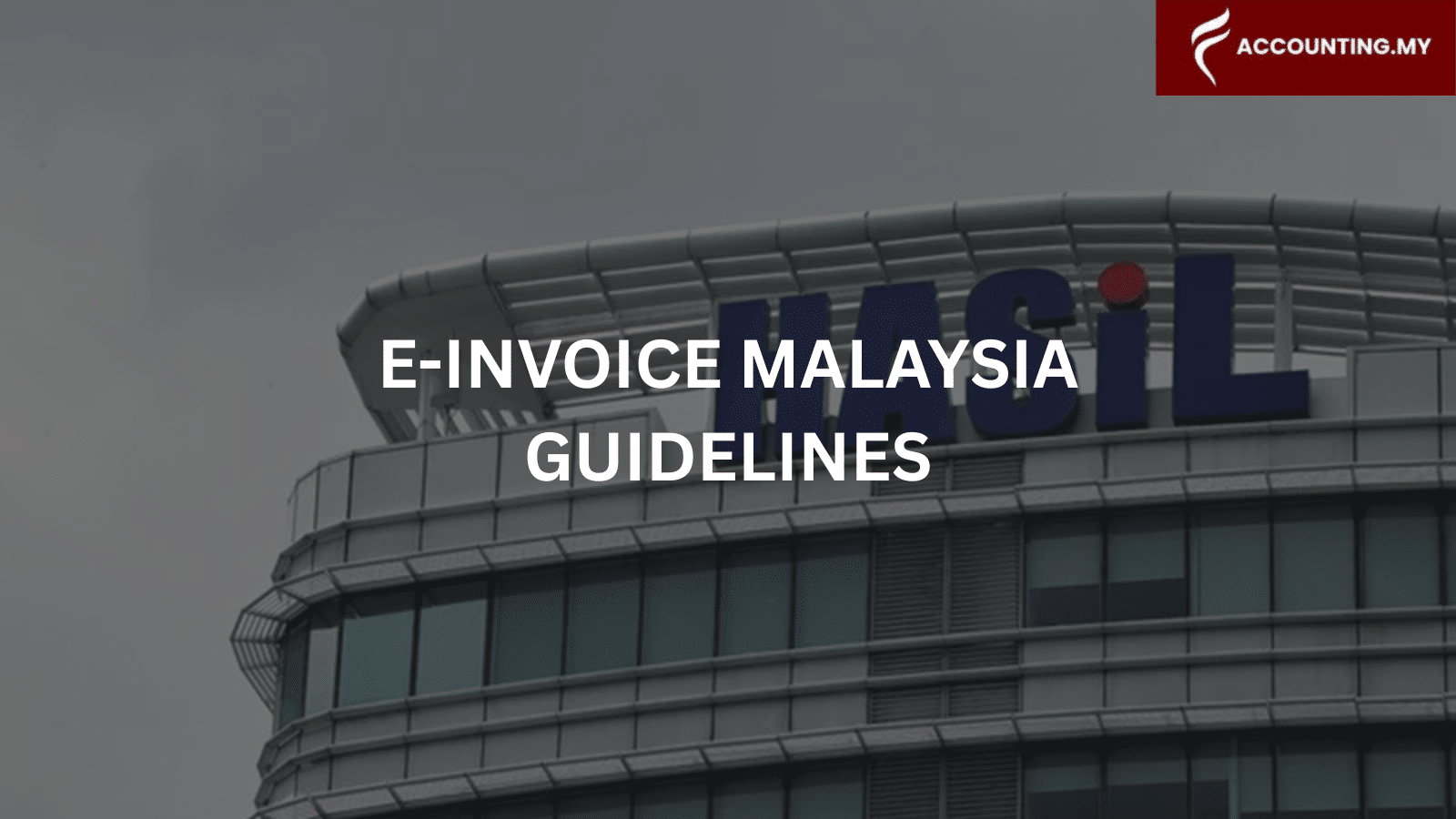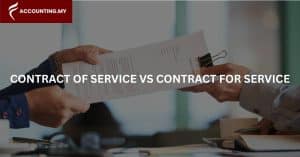
- Accounting.my
- April 4, 2025
- 8:45 am

E-invoicing Malaysia Guidelines: What You Need To Know
The digital transformation of business documentation is rapidly advancing, making robust accounting services more important than ever for businesses seeking to adapt efficiently.
Table of Contents
ToggleWith the mandatory rollout of e-invoicing starting August 1st, 2024, Malaysian businesses must adapt to the everchanging tides. Although the Inland Revenue Board of Malaysia (IRBM) provides comprehensive guidelines, it’s natural to have questions and queries about the process.
This guide aims to address those concerns and offer a comprehensive overview of e-invoicing in Malaysia. So, let’s get right to it.
What is e-invoice?
Essentially, e-invoicing is the electronic issuance and exchange of invoice documents between suppliers and buyers. Instead of paper, information is transmitted digitally in a structured format. This not only speeds up transactions but also enhances accuracy and reduces the risk of errors. Think of it as upgrading from handwritten notes to sending a well-formatted digital document.
Who Needs to do e-invoicing in Malaysia
E-invoicing applies to all persons in Malaysia, the list is lengthy but it generally includes:
- Association
- Body of persons
- Branch
- Business trust
- Co-operative societies
- Corporations
- Limited liability partnership
- Partnership
- Property trust fund
- Property trust
- Real estate investment trust
- Representative office and regional office
- Trust body
- Unit trust
All individuals and legal entities conducting business in Malaysia must comply. It’s important to note that personal transactions, such as routine grocery shopping or buying bubble tea, are excluded from these requirements.
Transaction Types
B2B (Business-to-Business): This is the most common type, involving the exchange of goods or services between companies. E-invoicing streamlines these interactions by providing a standardised and efficient method for invoice delivery and processing. Very beneficial supply chain management and trade.
B2C (Business-to-Consumer): Most prominently found in the retail industry. While the volume of B2C transactions can be very high, e-invoicing aims to bring the same efficiency and accuracy to these interactions, though there may be specific considerations for handling large numbers of consumer invoices.
B2G (Business-to-Government): E-invoicing also facilitates transactions with government agencies, ensuring transparency and accountability in public procurement and other government-related financial dealings. This helps reduce administrative burdens for both businesses and government departments.
Types of E-invoice in Malaysia
Malaysia’s e-invoicing system accommodates various transaction scenarios through different types of e-invoices, each serving a specific purpose:
Standard Invoices: These are the most common type, utilised for routine sales transactions when goods or services are exchanged between a supplier and a buyer. A standard invoice details the specifics of the transaction, including the items or services, quantities, prices, and any applicable taxes.
Credit Notes: Credit notes are issued by a supplier to a buyer to make adjustments to a previously issued invoice. This might be necessary to rectify errors in the original invoice, account for discounts, or process refunds for returned goods or cancelled services. Accurate bookkeeping is a-must for managing these adjustments.
Debit Notes: Conversely, debit notes are used by a supplier to request additional payments from a buyer for charges that were not included in the original invoice. This could be for extra services provided, unforeseen costs, or corrections that increase the amount the buyer is liable to pay.
Self-Billed Invoices: In certain situations, the buyer might generate the invoice themselves, rather than the supplier. This is known as self-billing and is often agreed upon in specific commercial arrangements, such as those involving commission payments or supplier agreements where the buyer has detailed sales data.
E-invoicing Overall Workflow: A Step-by-Step Guide
For a clear explanation of the e-invoicing procedure in Malaysia, the following details the typical workflow. This outlines the sequence of steps from the generation of an e-invoice to its completion.
1. Issuance of e-invoice
The process begins when a transaction occurs, prompting the supplier to create an e-invoice. This digital document, inclusive of any necessary adjustments, is then shared with the Inland Revenue Board of Malaysia (IRBM) via the MyInvois Portal or API for validation.
2. Validation of e-invoice
IRBM undertakes a real-time validation process, verifying that the e-invoice meets all stipulated standards and criteria. Once validated, a Unique Identifier Number is assigned, enhancing traceability and reducing the potential for tampering.
3. Notification of validated e-invoice
Upon successful validation, both the supplier and buyer are notified by IRBM through the MyInvois Portal or APIs. This notification confirms the e-invoice’s acceptance into the system.
4. Sharing of e-invoice
The supplier then shares the validated e-invoice, which includes a QR code, with the buyer. This QR code allows for verification of the e-invoice’s existence and status via IRBM’s official portal.
5. Rejection or cancellation of e-invoice
In cases where rejection or cancellation is required, a stipulated time period is allotted. The buyer can request rejection, and the supplier can initiate cancellation, both of which must be accompanied by valid justifications.
6. MyInvois Portal
Both the supplier and the buyer can access a summary of their e-invoice transactions through the MyInvois Portal, providing a comprehensive overview of their digital invoicing activities.
Requirements For E-invoicing in Malaysia
To meet the standards set by the IRBM for electronic invoicing, businesses must fulfil a set number of important criteria. To simplify the process, here is what you need to know.
Format
E-invoices are required to be structured using either XML or JSON formats, rather than PDF or JPEG. They must also include specific data, such as details of the supplier and buyer, the invoice number, a description of the items, and tax amounts.
Transmission
E-invoices need to be sent to the IRBM through the MyInvois portal or an API for validation before they can be given to the buyer. PEPPOL providers are validated by MDEC to support proper transmission.
Security
A digital certificate is necessary for authentication and security purposes, and it works to protect data using encryption.
Archiving
Both the sender and the receiver must keep validated e-invoices for a minimum of 7 years. If a business wants to store these invoices outside of Malaysia, they’ll need to get permission from the Director General of the Royal Malaysian Customs.
What is The E-Invoicing Implementation Timeline in Malaysia?
|
|
Taxpayers Targeted |
|
1 August 2024 |
Businesses with an annual turnover exceeding RM100 million |
|
1 January 2025 |
Businesses with an annual turnover between RM25 million and RM100 million |
|
1 July 2025 |
Businesses with an annual turnover between RM500,000 and RM25 million |
|
1 January 2026 |
Businesses with an annual turnover up to RM500,000 |
|
Note: Micro SMEs earning below RM150,000 annually are exempted from e-invoicing. |
|
What Are The Penalties For Failing To Issue An E-Invoice?
Failure to issue e-invoices constitutes an offense under Section 120(1)(d) of the Income Tax Act 1967.
This can result in harsh penalties, including fines ranging from RM200 to RM20,000, imprisonment for a term of up to six months, or both.
Additionally, non-compliance may lead to further penalties under existing tax regulations, such as those related to Sales and Service Tax (SST). So do your due diligence and ensure you adhere to the guidelines and compliance requirements.
Benefits of E-invoicing
Although adopting e-invoicing may seem like a regulatory compliance and nothing more, it actually brings a whole range of advantages for businesses, leading to improved efficiency, cost savings, and a more streamlined operation.
Faster Transactions: E-invoicing significantly speeds up the invoicing process. Instead of waiting for paper invoices to be printed, mailed, and processed, e-invoices are sent and received electronically, reducing delays and accelerating payment cycles.
Enhanced Efficiency: E-invoicing streamlines workflows, freeing up staff from time-consuming administrative tasks. This allows employees to focus on more strategic and value-added activities.
Better Cash Flow: Quicker payment processing and reduced delays contribute to improved cash flow. Businesses receive payments faster and can better manage their finances.
Stronger Security: E-invoicing systems often incorporate security measures like digital signatures and encryption, which help to protect against fraud and ensure the integrity of invoice data.
Easier Auditing: Digital records are easier to store, retrieve, and audit. E-invoicing simplifies the audit process for both businesses and potential tax relief claims.
Conclusion On e-invoicing Malaysia Guidelines
So there you have it, a detailed guideline to e-invoicing in Malaysia.
If you find yourself overwhelmed by the intricacies of e-invoicing or need assistance in setting up your company to handle these new requirements, Accounting.my is here to help.
Delegate these routine tasks to our experienced team and free up valuable time to focus on growing your business with our bespoke tax services!
Contact us today and discover how we can streamline your e-invoicing and accounting needs!
Frequently Asked Questions About e-invoice Malaysia
How Does e-invoice Differ From Traditional Invoice?
Traditional invoices are typically paper-based or simple digital documents (like PDFs), while e-invoices are structured digital data transmitted directly to LHDN for validation, enabling real-time reporting and automated processing.
Should Businesses Keep Both Paper and Electronic Copies of Invoices During the Transition?
While the transition occurs, it is important to maintain both electronic and paper records for a short period, especially for audit purposes, but the official record is the validated electronic version.
Are Cross-Border Transactions Subject to Malaysian e-invoicing Requirements?
Yes. Transactions involving Malaysian businesses, even those with international clients or suppliers, are subject to Malaysian e-invoicing requirements for the Malaysian portion of the transaction.
Can I Use My Existing Accounting Software for e-invoicing, or Do I Need to Purchase New Software?
You might be able to use your existing accounting software, but it needs to be compatible with LHDN’s e-invoicing requirements. Check with your software provider about updates or API integration options.
Can e-invoices Be Used for Tax Relief Claims?
Yes. Validated e-invoices serve as official records for tax relief claims, providing the necessary documentation to support deductions as allowed under Malaysian tax laws.
What Happens if I Issue an Invoice to a Customer Before the E-invoicing Mandate Applies to My Business?
If you issue a traditional invoice before your mandatory e-invoicing date, that’s generally acceptable. E-invoicing becomes a requirement from the date specified by LHDN for your business’s turnover bracket.
Popular Post


Top 10 PR Agencies in Malaysia (And Who They’re Best For)

How to Apply for a Food Handling Certificate in Malaysia

Best 10 KSL Hair Salon: Where All Locals & Singaporeans Go

Enterprise vs Sdn Bhd: What Malaysian Owners Must Know

Sick Leave in Malaysia: Rules, Rights & HR Guide

Contract of Service vs Contract for Service in Malaysia Explained

Malaysia first AI bank – Ryt Bank Launches 18 August 2025

We Offer FREE HRDF Claimable E-Invoice Training (If You Contribute)


